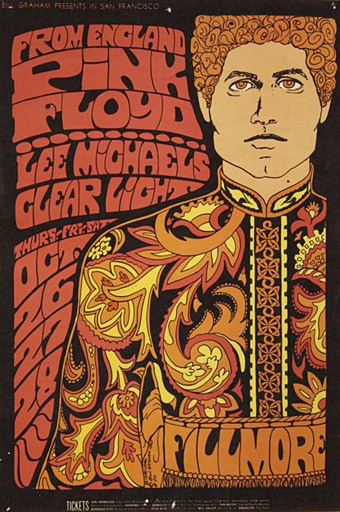Pink Floyd, Lee Michaels, Clear Light (1967) by Bonnie MacLean.
• Electronic musician Mort Garson has been subject to a revival of interest recently, with reissues of his works as Ataraxia (The Unexplained), and Lucifer (Black Mass). The latest reissue is Mother Earth’s Plantasia (1976), an album released under Garson’s own name, and one of several works of plant mysticism from the 1970s (see Stevie Wonder’s Journey Through The Secret Life Of Plants, and Green by Steve Hillage).
• “It is striking how much of this work sounds like a missing link from the art world to the popular groups of the time, such as the Detroit techno pioneers Cybotron and the Japanese electro legends Yellow Magic Orchestra.” Geeta Dayal on the reconfigured Speak & Spell machinery of Paul DeMarinis.
The cost of free love and the designers who bore it: Madeleine Morley meets the women of psychedelic design.
For the transhumanist anarchist Wilson, the neurological relativism revealed by his own learning and personal deprogramming experiments called for a form of ‘guerrilla ontology’ that lampooned, rejected and transmitted much needed interference into the ‘reality tunnels’ that attempt to control much of contemporary society and individual behaviour. In the Schrödinger’s Cat Trilogy, characters are repeatedly placed in positions of cognitive dissonance, where they are forced to reevaluate their own belief systems due to experiences that they are unable to accommodate.
Sean Kitching on the 40th anniversary of Robert Anton Wilson’s Schrödinger’s Cat Trilogy
• They said books were dead, they were wrong: Adrian Shaughnessy on a decade of Unit Editions.
• Mixes of the week: Xianedelica by Jesús Bacalão, and Kosmische Mix By Tarotplane.
• Swinging 60s surrealist Penny Slinger: “Collectors thought I came with the art”.
• Cabaret Voltaire: Chance Versus Causality (Teaser).
• Luc Sante on postcards of American violence.
• At Dennis Cooper’s: Peter Whitehead Day.
• Computerwelt (1981) by Kraftwerk | Speak And Spell (1984) by Christina Kubisch | Time Space Transmat (1985) by Model 500


The reference to the work of Mort Garson and plant mysticism reminded me of a passage in Poe’s The Fall of the House of Usher which I happened to have listened to on audiobook this week. A passage I don’t think I had really ever noticed before.
“…an opinion of Usher’s which I mention not so much on account of its novelty, (for other men have thought thus,) as on account of the pertinacity with which he maintained it. This opinion, in its general form, was that of the sentience of all vegetable things. But, in his disordered fancy, the idea had assumed a more daring character, and trespassed, under certain conditions, upon the kingdom of inorganization. I lack words to express the full extent, or the earnest abandon of his persuasion. The belief, however, was connected (as I have previously hinted) with the gray stones of the home of his forefathers. The conditions of the sentience had been here, he imagined, fulfilled in the method of collocation of these stones — in the order of their arrangement, as well as in that of the many fungi which overspread them, and of the decayed trees which stood around — above all, in the long undisturbed endurance of this arrangement, and in its reduplication in the still waters of the tarn. Its evidence — the evidence of the sentience — was to be seen, he said, (and I here started as he spoke,) in the gradual yet certain condensation of an atmosphere of their own about the waters and the walls. The result was discoverable, he added, in that silent, yet importunate and terrible influence which for centuries had moulded the destinies of his family, and which made him what I now saw him — what he was. Such opinions need no comment, and I will make none.”
Despite my having illustrated the story quite recently I didn’t remember that passage either. And by coincidence (or is it, etc), I noticed this story earlier today:
https://www.theguardian.com/science/2019/jul/03/group-of-biologists-tries-to-bury-the-idea-that-plants-are-conscious
Somewhere I still have a paperback of Lyall Watson’s Supernature (1973), another example of plant consciousness theorising from the 1970s. Less cranky than most since he was trying to keep within scientific bounds.